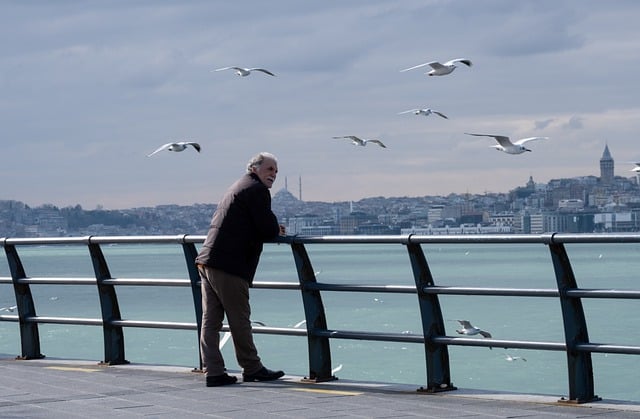|
GAVIOTAS
|
| Gracias a:Sara32_jabar |
|
Text 1: In the image, we see a man leaning against a metal railing, looking out over the calm water. Above him, a group of seagulls is flying in various directions, their wings spread wide as they glide through the sky. The man appears thoughtful, observing the scenery around him. There are several buildings visible in the distance, which create a faint cityscape background. The sky is overcast, with thick clouds that give a slightly somber tone to the scene. The seagulls seem to be floating effortlessly, and their presence adds movement to an otherwise still moment. The man is dressed in casual clothes, wearing a dark jacket and pants. The colors of the scene are muted, with blues, greys, and greens dominating the image, which contributes to the overall peaceful and reflective mood. The seagulls are the most dynamic part of the scene, with their movement contrasting with the man’s stillness. Text 2: The image depicts a man standing by a metal railing, gazing out over a wide river. A few seagulls are perched on the railing near him, while others are flying over the water. The man seems relaxed, as if enjoying the view and the company of the birds. The background is filled with a vast open sky, partially cloudy, and some buildings that are not very distinct. The water below is still, with no visible waves. The seagulls add a lively element to the image, with some appearing to take off from the railing. The man's casual clothing, consisting of a light jacket and jeans, makes the scene feel informal and comfortable. The seagulls and the serene environment give the impression of a peaceful moment in nature. Text 3: In this image, an older man is leaning against a railing, overlooking the calm water below. Above him, several seagulls are flying, their wings spread as they circle over the water. The man appears to be enjoying the scenery, perhaps lost in thought as he watches the birds glide effortlessly. In the background, the cityscape is visible, with several buildings and a tower standing out against the cloudy sky. The sky is mostly overcast, with clouds that suggest an early morning or late afternoon. The seagulls are scattered in the air, some closer to the man while others are further away, creating depth in the image. The colors in the scene are mostly neutral, with shades of blue and grey dominating, which contributes to the tranquil and contemplative atmosphere. The railing and the man’s posture suggest a quiet moment of reflection, while the seagulls bring a sense of movement.
Seagull - Gaviota: Ave que se ve volando sobre el agua en la imagen, común en áreas costeras y puertos. Railing - Barandilla: Estructura metálica contra la cual el hombre se apoya, que sirve de protección. Water - Agua: Superficie acuática visible en la imagen, sobre la cual vuelan las gaviotas. Sky - Cielo: Parte superior de la imagen, está mayormente cubierto de nubes. Clouds - Nubes: Formaciones visibles en el cielo que le dan un tono nublado a la escena. Cityscape - Panorama urbano: Los edificios visibles al fondo de la imagen, que sugieren la presencia de una ciudad. Leaning - Apoyándose: Acción del hombre que se encuentra inclinado contra la barandilla, mostrando una postura relajada. Jacket - Chaqueta: Prenda de vestir que lleva el hombre, adecuada para el clima fresco. Thoughtful - Pensativo: Estado en el que parece encontrarse el hombre, observando el paisaje. Building - Edificio: Estructuras visibles en el fondo de la imagen, que forman parte del panorama urbano. Muted colors - Colores apagados: Colores poco saturados presentes en la imagen, como el azul, gris y verde. Tranquil - Tranquilo: Describe la atmósfera de la escena, que transmite paz y quietud. Overcast - Nublado: Describe el cielo cubierto de nubes que se observa en la imagen. Gliding - Planeando: Movimiento que hacen las gaviotas en el aire, manteniéndose sin mucho aleteo. Fence - Valla: Estructura similar a la barandilla que se utiliza para separar áreas o como protección, en este caso sirve para delimitar el área junto al agua. |





